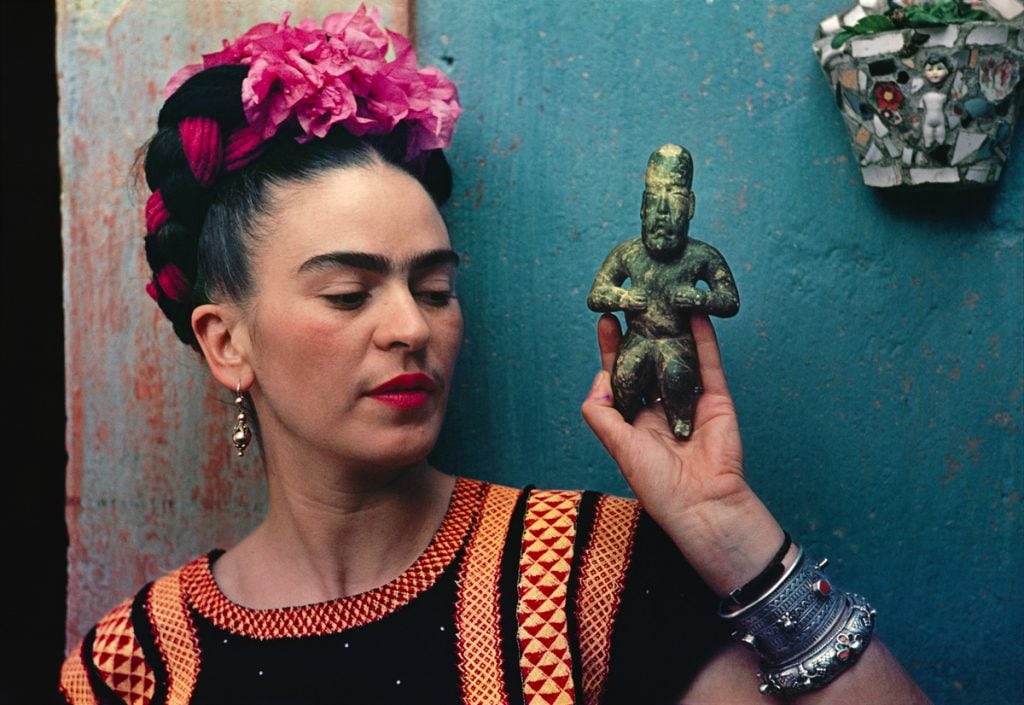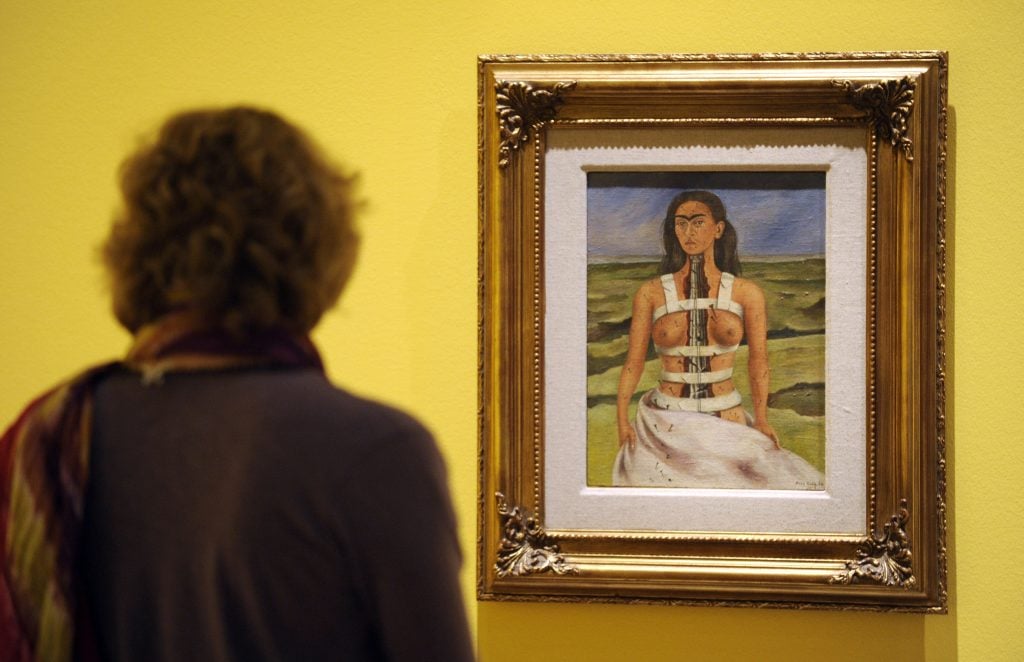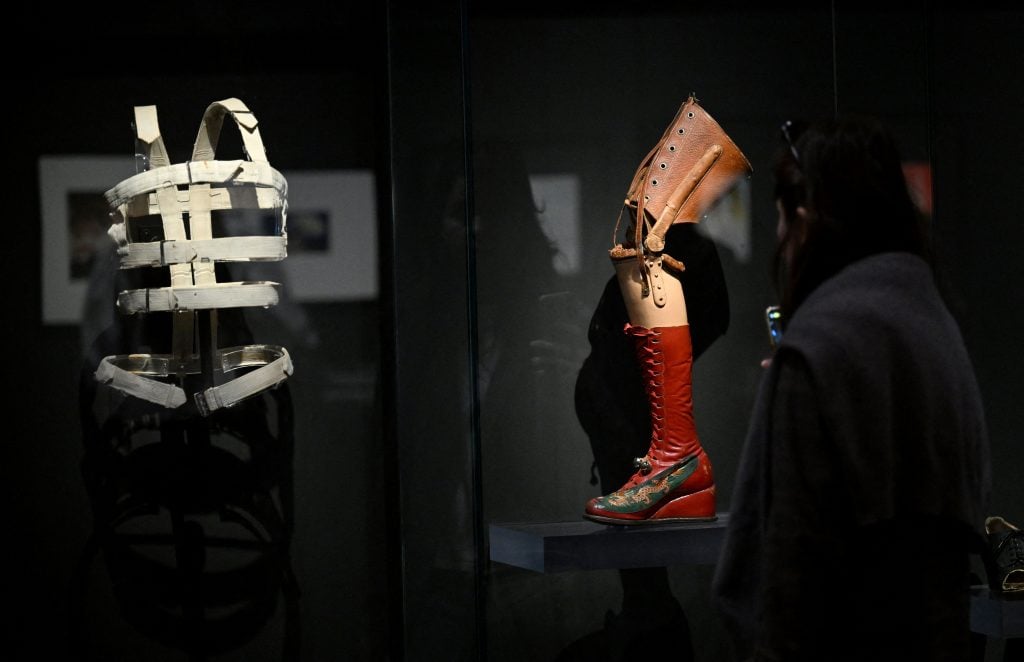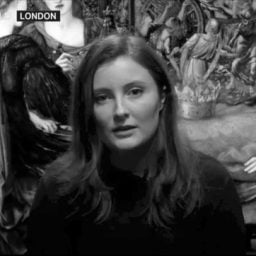Art History
Does Frida Kahlo’s Art Hold the Key to a Hidden Medical Condition?
Seventy years after her death, a team of doctors has suggested a new diagnosis for the artist's back pain.

Frida Kahlo’s many self-portraits are often read as an outward expression for her decades-long internal battle with deteriorating health and chronic pain. One example is The Broken Column (1944), made just after a spinal surgery, in which her torso appears ripped open to reveal a cracked Ionic column on the verge of crumbling. Kahlo is shown held together by a steel brace and, though her expression is stoic, tears roll down her cheeks.
Thanks to works like these, Kahlo’s experiences with disability after surviving a devastating road accident at the age of 18 are well known. Surprisingly, however, these paintings and the Mexican artist’s written accounts of her condition have also provided sufficient basis for a team of neurologists in Spain to give Kahlo a posthumous diagnosis of cauda equina syndrome (CES). Their findings were published recently in the Journal of Neurology.
When a trolley car collided with the bus she was riding, Kahlo suffered multiple serious injuries. A metal rod tore through her midsection, her right foot was crushed, she sustained multiple fractures in her ribs and pelvis, and her ankles and shoulders were dislocated. Most significantly, two of her lumbar vertebrae, known medically as L3-4 to denote their position, were also fractured and dislocated.

A visitor looks at the painting The Broken Column by Mexican artist Frida Kahlo at the Martin-Gropius-Bau museum in Berlin in 2010. Photo: John Macdougall/ AFP via Getty Images.
In order to heal, Kahlo was put in a full-body plaster cast and spent a month in hospital and a further two months recovering at home. Today, it is known that the plaster casts and immobilization used to treat her injuries often lead to significant muscle atrophy, worsening pain and gait disorders, according to the journal article’s authors Oyku Arslantas, Sergiu Albu, Josep Valls‑Sole, and Hatice Kumru. This “likely contributed to Kahlo’s ongoing disability,” they added.
“Sometimes I have a pain that nothing can take away,” the artist wrote in a letter from April 25, 1927. Painting became a source of solace as she came to terms with the fact that her life would never be the same again.
In the aftermath of the accident, Kahlo experienced both persistent lower back pain and “pain in her legs predominantly [on the] right side and genital pain consistent with neuropathic pain,” according to the researchers. Unfortunately, in the decades that followed, Kahlo’s condition gradually worsened despite her undergoing various operations and wearing an uncomfortable orthopedic corset to improve mobility.
Notes from an examination in 1930 by Dr. Leo Eloesser recorded “decreased sensitivity in the lower part of her body,” which he attributed to spina bifida, a birth defect that Kahlo may also have had.
The researchers interpret The Broken Column as proof that Kahlo’s “fractured spine [was] the main source of her pain.” She died at the age of 47 in 1954, following an unsuccessful spinal fusion on three dislocated vertebrae that resulted in infection. Some speculate that she may have died by suicide as her nurse claimed she had intentionally overdosed on painkillers.

Orthopaedic aids which belonged to late Mexican artist Frida Kahlo, at “Frida Kahlo, Beyond Appearances” exhibition at Palais Galleria in Paris in 2022. Photo: Emmanuel Dunand / AFP via Getty Images.
According to the paper, “CES is a rare condition caused by compressive lesion in the lumbar spine that affects some or all of the peripheral nerve roots,” in particular the cauda equina nerves in the lower spinal cord. It comes with symptoms like lower back pain, leg pain, leg weakness, numbness or other sensations like tingling.
Though Kahlo herself defined these symptom as Sciatica, the researchers believe the “decreased sensitivity in the lower part of her body” described by her physician Eloesser, may in fact have been a sign of CES. They say it would be typical for this syndrome to be caused by the vertebral fractures at L3-4 that she sustained from the bus accident.
They also noted that Kahlo’s symptoms are unlikely to be caused by the polio infection she contracted as a child, since they began at 18 years old. The disease left her right leg thinner than her left, yet the onset of post-polio syndrome would typically arrive much later in life and would not typically cause sensory loss.
“This study is a historical case report, and as such, it has several limitations,” the researchers acknowledge, citing the lack of comprehensive data from a complete neurological examination of Kahlo. The add, however, that “the connection between her art and her medical conditions adds depth to understanding her work and life story.”





